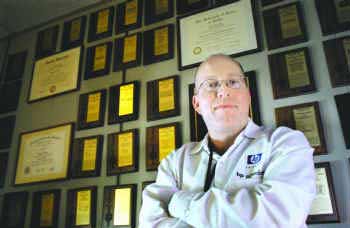written by Cheryl Hall: The Dallas Morning News
8:12 AM CST on Wednesday, February 22, 2006, RICHARDSON, Texas
re-posted with her permission
written by Cheryl Hall: The Dallas Morning News
8:12 AM CST on Wednesday, February 22, 2006, RICHARDSON, Texas
re-posted with her permission
The 45-year-old distinguished technologist for Hewlett-Packard Co. teaches the art of innovation to H-P troops around the country. Apparently, he's pretty effective. Last year, H-P produced 1,797 patents, third behind only International Business Machines Corp. and Canon Kabushiki Kaisha in U.S. Patent and Trademark Office proficiency. Eight of those patents bore Mr. Belady's name. Since joining H-P in 1995, he's come up with more than 100 inventions to make computing hardware more powerful and energy efficient, Patent No, 41 was issued yesterday.
Another legacy is even more important to Mr. Belady. He wants to teach his two children through the power of imaginative play - just as his father did. He wants you to do the same. Give children boxes and throw away the toys, Mr. Belady pleads. Toys that are too realistic and electronic games are numbing the creativity that has made Americans innovative leaders. His 4-year-old son and 7-year-old daughter can't watch more than an hour of TV each day and must play outside for an hour - even when it's raining. Except for the formal areas, the family's house in McKinney is in a perpetual state of mess with kid projects. |
 photo by DARNELL RENEE Christian Belady, Hewlett-Packard's steward of innovation, has invented over 100 ways to improve computing hardware. |
His 77-year-old father, Laszlo Belady, a Hungarian immigrant and a founder of Austin's Microelectronics and Computer Technology Corp., made Christian use his mental prowess to create playthings.
At age 8, Christian and his father built a stereo from a Heathkit do-it-yourself kit. When they turned on their masterpiece for the first time, it didn't work. But by building it with him, I got so good at reading schematics that I found the missing diode from the thousands in the circuit,
he says.
The next year, Christian wanted a go-cart like the ones his buddies were driving down the hills of Yorktown Heights, N.Y. His father tossed him three wheels in the garage and challenged him to make one. Mine had two wheels in the front and one in the back and was a deathtrap,
he says. It taught me the importance of stability.
And yes, Christian blew up his high school chemistry lab by pouring acetone, not water, into a beaker on a Bunsen burner. From that I learned to always, always read the label.
Innovation is often the beautiful blossom of blunders. You have to give people the opportunity to take multiple roads, including wrong ones. You learn from your failures and do things better the next time.
Mr. Belady has trouble remembering any recent missteps. Since I am an eternal optimist, I tend to delete all failures from my mind - another characteristic of an inventor,
he laughs. An optimist forgets the failures and gets addicted to the success.
He's been called a deviant, which he considers high praise. Innovation is deviation. If you don't create an environment where people can deviate from defined processes, they can't innovate.
Like his father, he revels in going against the grain. If someone tells me it can't be done, I immediately start thinking how I can do it. It's the same with my team here. We lock ourselves in a room and figure out a solution.
That happened in 2001, when H-P needed a processing module with twice as many processors in the same space and with 10 times the thermal energy efficiencies. We had a problem, and no one had a solution. We came up with one. It was a blast.
The most powerful tool in innovation is a one-word question: Why? Why? Because when we question basic assumptions of what we think of as the norm, we find the opportunities.
proceed to page 2: Innovation Brain Patterns
![]()
to Innovation Brain Patterns
to ie-Chemistry menu
to ie-Physics menu
to site menu